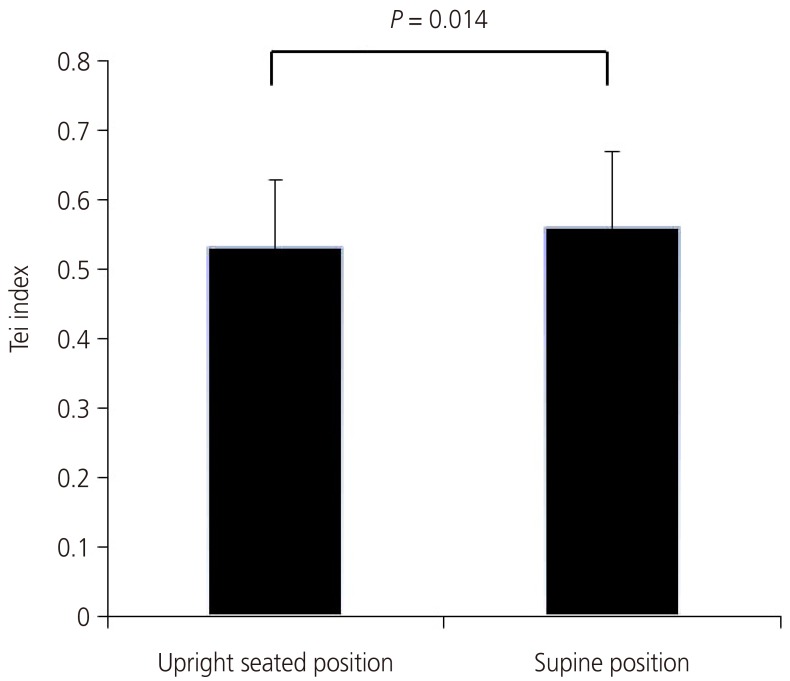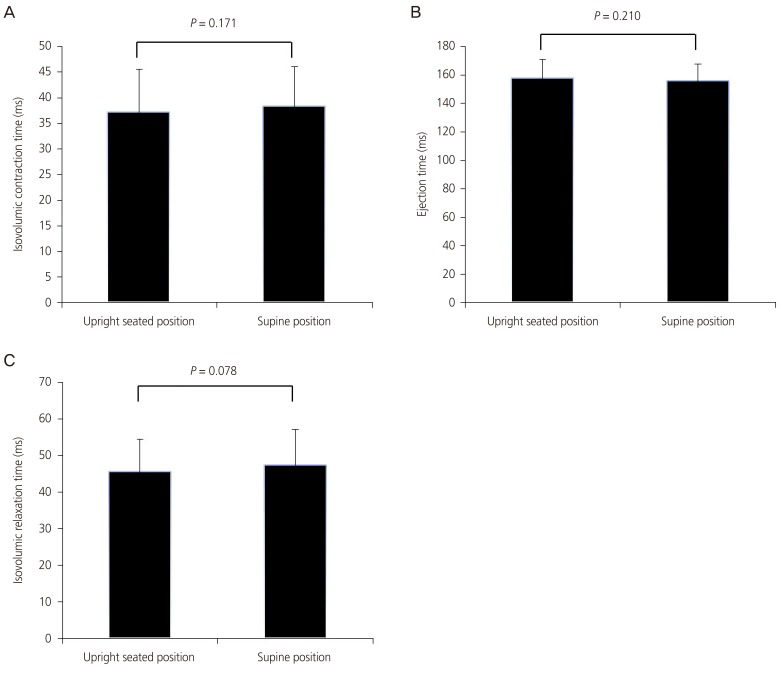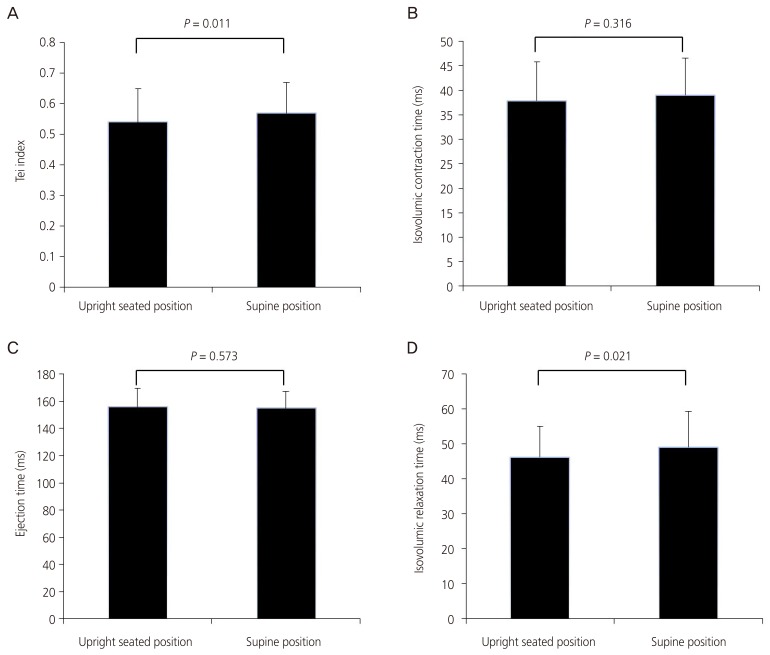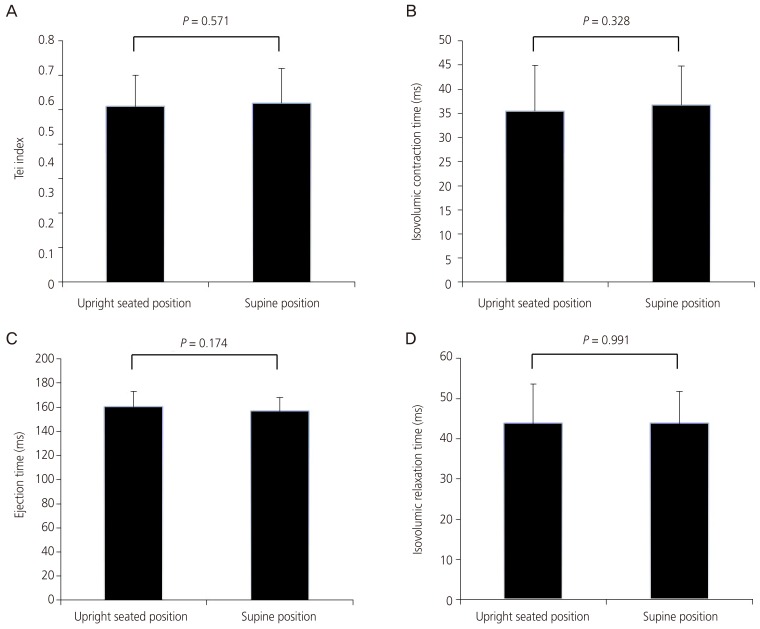Abstract
Objective
The cardiovascular system maintains homeostasis through a series of adaptive responses to physiological requirements. However, little is known about the adaptation of fetal cardiac function to gravity, according to gestational age. In the present study, we aimed to evaluate the adaptive responses of cardiac function to postural changes, using Tei index measurements.
Methods
Fetal echocardiography and Doppler examination were performed on 114 women with vertex singleton pregnancies at 19 to 40 weeks' gestation. Participants were placed in an upright seated position, and the Tei index for fetal left ventricular cardiac function was measured. The women were then moved into a supine position and the Tei index was re-measured.
Results
The mean Tei index when measured in an upright seated position was significantly lower than that measured in a supine positioning for all fetuses (0.528±0.103 vs. 0.555±0.106, P=0.014, respectively). This difference was also noted in fetuses with a gestational age of 28–40 weeks (0.539±0.107 vs. 0.574±0.102, P=0.011, respectively). However, there was no difference in the Tei index between an upright seated and a supine position among fetuses with a gestational age of <28 weeks (0.505±0.091 vs. 0.516±0.103, P=0.571, respectively).
Go to : 
When the human body changes position, the autonomic nervous system regulates cardiac function to maintain a stable internal environment [1]. The heart must counteract the force of gravity in the vertical (standing or sitting) posture, and thus needs to withstand added gravitational stress while preserving systemic blood pressure and cerebral perfusion [2]. To maintain normal mean aortic pressure, a person who is standing upright develops increased systemic vascular resistance (due to sympathetic activation of resistance vessels), decreased venous compliance (due to sympathetic activation of veins), decreased stroke volume and cardiac output (due to decreased preload), and increased heart rate (baroreceptor-mediated tachycardia) [3]. Therefore, in healthy adults, sympathetic nervous function predominates in vertical postures, while parasympathetic function predominates in recumbent postures [4].
However, adaptive responses of fetal cardiac function to postural change, according to gestational age, have not yet been fully studied. It is known that the fetal autonomic nervous system and cardiac function develop as gestation progresses [56], and these functions are reflected in the correlation of fetal heart rate fluctuations with gestational age [7]. Therefore, it is important to study how fetal cardiac function responds to postural changes, as gestational age increases.
The Tei index—defined as the sum of the isovolumic contraction time (ICT) and isovolumic relaxation time (IRT), divided by the ejection time (ET) in each ventricle—is used to assess myocardial performance. Ventricular dysfunction results in the prolongation of both ICT and IRT, and the diminution of ET [8]. The calculation of the Tei index is not based on a geometric model or on volume measurements, but is a ratio of time intervals, independent of ventricular geometry, blood pressure, heart rate, and age [9]. Therefore, the Tei index can be easily obtained in a fetus without the need for precise anatomic imaging, and is a useful tool to evaluate fetal myocardial function in many clinical situations [10]. In the present study, we aimed to evaluate the adaptive responses of cardiac function to postural changes, through Tei index measurements.
Go to : 
This was a prospective study conducted between January and May 2013 at Korea University Guro Hospital, Korea. We enrolled 114 women with singleton pregnancies and no maternal risk factors. Participants were between 19/0 and 40/6 weeks’ gestation, with cephalic presentation, and had an estimated fetal weight between the 10th and 90th percentiles. Fetuses with any congenital malformations or chromosomal anomalies, and pregnancies with complications such as intrauterine growth restriction, were excluded.
The gestational age of each fetus was calculated according to the duration of amenorrhea, and was confirmed at first-trimester ultrasonography. The institutional review board approved this study, and informed consent was obtained from all participants.
In the initial evaluation, pregnant women were placed in an upright seated position, and the Tei index was measured for cardiac function in the left ventricle. After completion of the upright seated measurements, pregnant women were again brought to the supine position for additional supine measures while ultrasound probe was placed on abdomen. An interval of less than 1 minute was usually maintained between the two measurements (Fig. 1).
A specially trained obstetrician recorded the ultrasonographic measurements with a GE E8 ultrasound system (GE Healthcare Technologies, Milwaukee, WI, USA). A cross-sectional image of the apical four chamber view was obtained. To measure the Tei index, the Doppler sample volume was placed below the mitral valve towards the ventricular septum, with the pulsed Doppler trace including the EA waveform (positive) and the aortic (negative) blood flow waveforms. A minimum of three pulsed Doppler waveforms were measured, and the time-averaged mean value was used for analysis.
Three time-periods were then calculated: 1) ICT from the end of the EA waveform until the beginning of the aortic flow; 2) ET from the beginning to the end of the aortic flow; and 3) IRT from the end of the aortic flow until the beginning of the EA waveform (Fig. 1). The Tei index is defined as the sum of the ICT and IRT, divided by the ET in each ventricle [Tei index=(ICT+IRT)/ET].
All numeric data are expressed as mean ± standard deviation. The echocardiographic indices of the fetuses at each measurement were compared using paired t-tests. Statistical significance was defined as P<0.05. PASW ver. 18.0 (SPSS Inc., Chicago, IL, USA) was used for statistical analysis.
Go to : 
The mean participant age and fetal gestational age were 30.23±2.31 years and 29.49±6.49 weeks, respectively. The Tei index was assessed in all cases. The mean Tei index when mothers were placed in an upright seated position was significantly lower than that in the supine position, among all fetuses (Fig. 1). However, ICT, ET, and IRT were not different between the upright seated and supine positions (Fig. 2).
Participants were divided into two subgroups for additional analysis. One group consisted of fetuses with a gestational age of 28 to 40 weeks (n=77), and the other group included fetuses with a gestational age of <28 weeks (n=37). The mean Tei index and IRT associated with the upright seated position were significantly lower than in the supine position, among fetuses with a gestation age of 28 to 40 weeks (Fig. 3). However, other parameters including ICT, and ET, were not different by postural change in this subgroup (Fig. 3). There was no difference in the Tei index, ICT, ET, IRT between the upright seated and supine positions, among fetuses with a gestational age of <28 weeks (Fig. 4).
Go to : 
In this study, we evaluated the effect of fetal postural changes on the Tei index, and found that the mean Tei index when mothers were seated upright was significantly lower than that in the supine position, for all fetuses and for fetuses with a gestational age of 28 to 40 weeks. IRT in the upright seated position was significantly lower than that in the supine position for fetuses with a gestational age of 28 to 40 weeks, while other parameters including ICT and ET did not differ according to maternal position. These results suggest that the Tei index may increase when a pregnant woman is in the supine position, because of an increase in IRT in fetuses with a gestational age of 28 to 40 weeks.
Within the Tei index, ICT primarily reflects systolic cardiac function while IRT reflects diastolic function [11], and increased IRT indicates changes in diastolic function. In normal adults, simple postural changes will alter measurements of diastolic function [12]. The response of Doppler-derived measurements of diastolic function to postural changes is complex and multifactorial [13], and a modification in autonomic tone substantially changes the Doppler-derived pattern of diastolic filling in normal subjects [12]. Therefore, after a person stands suddenly or is placed in an upright tilt position, there is a significant increase in IRT [1314]. This adaptation of the normal heart to tilting is based on a ventricular interaction and on the diastolic properties of the left ventricle [15]. The decrease in left ventricular ET caused by a decrease in preload during passive upright tilt is accompanied by a partially compensatory increase in IRT [16].
However, in the present study, the mean Tei index when measured in the upright seated position was significantly lower than that in the supine position, for all fetuses and for fetuses with a gestational age of 28 to 40 weeks. We believe that a correlation between maternal posture and fetal position explains this result. When a mother is upright and seated, the fetus assumes a vertex presentation. However, when a mother is supine, the fetus is likely to assume a posterior or transverse spinal position [17]. Therefore, when a mother is in an upright and seated position, her fetus turns upside down and the fetal heart does not need to overcome as much gravitational force. Conversely, when a mother is in a supine position, her fetus is also lying down and thus the fetal heart needs to overcome a much greater gravitational force than when the mother is upright and seated. This can explain why the mean Tei index during maternal supine positioning was significantly higher than when mothers were in an upright seated position, for all fetuses and for fetuses with a gestational age of 28 to 40 weeks. Otherwise, Tei index can be also be changed by other factors including uterine artery blood flow, umbilical blood flow, and maternal venous return. However, unfortunately, we did not measure these factors. Thus, further studies with measurement of maternal and placental blood flow changes are needed to understand the mechanism for the adaptive responses of the fetal cardiovascular system to postural changes.
In this study, there was no difference in the Tei index when measured during an upright seated or a supine position, for fetuses with a gestational age of <28 weeks. Although the mechanism underlying this finding is unclear, there are several possible explanations. First, changes in the Tei index according to maternal posture among fetuses with a gestational age of >28 weeks may be due to the development of the fetal autonomic nervous system’s integrative capacity, which increases with gestational age. Effects related to fetal autonomic control are reflected in the fetal heart rate pattern, which is the only monitoring signal available from the fetus during the essential developmental period occurring in the second and third trimesters [18]. With increasing gestational age, the fetal autonomic nervous system develops further, and cardiac function also becomes better regulated because the autonomic nervous system provides a fine degree of control over the target organs, including the heart. Second, the change in amniotic fluid volume throughout pregnancy may influence the Tei index. It has been reported that beginning from a median of 10.3 cm at 15 weeks’ gestation, the amniotic fluid index increases progressively to a maximum median of 14.0 cm at 30 weeks, and then declines gradually to a median of 9.1 cm by 40 weeks’ gestation [19]. Therefore, amniotic fluid volume gradually declines after a gestational age of 30 to 40 weeks, while fetuses with a gestational age of <28 weeks have a larger volume of amniotic fluid. Consequently, fetuses with more amniotic fluid may be cushioned from postural changes and be less sensitive to changes in the cardiovascular system. Therefore, there was no difference in the Tei index between an upright seated and supine position, among fetuses with a gestational age of <28 weeks.
There are some limitations in this study that should be acknowledged. First, the mean Tei index was used for our analysis, and differences between fetuses were not examined. Therefore, the Tei index of each fetus was not analyzed individually according to increasing gestational age. Furthermore, this study only observed fetal cardiac function after postural changes from an upright seated to a supine position. To more clearly understand the adaptive responses of the cardiovascular system to postural changes, further studies are needed to evaluate fetal cardiac function during transition from a supine to an upright seated position, as well. Nevertheless, this is the first study to examine the adaptive responses of fetal cardiac function to changes in maternal posture.
In conclusion, this study demonstrated that maternal postural changes from an upright seated to a supine position resulted in an increased Tei index in fetuses with a gestational age of >28 weeks. These findings appear to reflect fetal maturation in terms of the adaptive responses of the cardiovascular system to postural changes. Further studies are needed to investigate whether the adaptive responses of the fetal cardiovascular system to postural changes can be a useful marker to predict non-reassuring fetal status in fetuses with intrauterine growth restriction or fetal anomaly including heart anomalies.
Go to : 
References
1. Boron WF, Boulpaep EL. Medical physiology. Philadelphia (PA): W.B. Saunders;2003.
2. Jones AY, Dean E. Body position change and its effect on hemodynamic and metabolic status. Heart Lung. 2004; 33:281–290. PMID: 15454907.

3. Klabunde RE. Cardiovascular physiology concepts. Philadelphia (PA): Lippincott Williams & Wilkins/Wolters Kluwer;2012.
4. Watanabe N, Reece J, Polus BI. Effects of body position on autonomic regulation of cardiovascular function in young, healthy adults. Chiropr Osteopat. 2007; 15:19. PMID: 18045493.

5. Fukushima A, Nakai K, Itoh M, Horigome H, Suwabe A, Tohyama K, et al. Assessment of fetal autonomic nervous system activity by fetal magnetocardiography. Clin Med Cardiol. 2008; 2:33–39.

6. Pennati G, Fumero R. Scaling approach to study the changes through the gestation of human fetal cardiac and circulatory behaviors. Ann Biomed Eng. 2000; 28:442–452. PMID: 10870901.

7. Wallwitz U, Schneider U, Nowack S, Feuker J, Bauer S, Rudolph A, et al. Development of integrative autonomic nervous system function: an investigation based on time correlation in fetal heart rate patterns. J Perinat Med. 2012; 40:659–667. PMID: 23093257.

8. Ichizuka K, Matsuoka R, Hasegawa J, Shirato N, Jimbo M, Otsuki K, et al. The Tei index for evaluation of fetal myocardial performance in sick fetuses. Early Hum Dev. 2005; 81:273–279. PMID: 15814209.

9. Lakoumentas JA, Panou FK, Kotseroglou VK, Aggeli KI, Harbis PK. The Tei index of myocardial performance: applications in cardiology. Hellenic J Cardiol. 2005; 46:52–58. PMID: 15807396.
10. Friedman D, Buyon J, Kim M, Glickstein JS. Fetal cardiac function assessed by Doppler myocardial performance index (Tei Index). Ultrasound Obstet Gynecol. 2003; 21:33–36. PMID: 12528158.

11. Tei C, Ling LH, Hodge DO, Bailey KR, Oh JK, Rodeheffer RJ, et al. New index of combined systolic and diastolic myocardial performance: a simple and reproducible measure of cardiac function. A study in normals and dilated cardiomyopathy. J Cardiol. 1995; 26:357–366. PMID: 8558414.
12. Plotnick GD, Kmetzo JJ, Gottdiener JS. Effect of autonomic blockade, postural changes and isometric exercise on Doppler indexes of diastolic left ventricular function. Am J Cardiol. 1991; 67:1284–1290. PMID: 2035455.

13. Kmetzo JJ, Plotnick GD, Gottdiener JS. Effect of postural changes and isometric exercise on Doppler-derived measurements of diastolic function in normal subjects. Chest. 1991; 100:357–363. PMID: 1864105.

14. Dernellis J, Tsiamis E, Stefanadis C, Pitsavos C, Toutouzas P. Effects of postural changes on left atrial function in patients with hypertrophic cardiomyopathy. Am Heart J. 1998; 136:982–987. PMID: 9842010.

15. Guazzi M, Maltagliati A, Tamborini G, Celeste F, Pepi M, Muratori M, et al. How the left and right sides of the heart, as well as pulmonary venous drainage, adapt to an increasing degree of head-up tilting in hypertrophic cardiomyopathy: differences from the normal heart. J Am Coll Cardiol. 2000; 36:185–193. PMID: 10898433.

17. Zhao XB, Shan JZ. Changing fetal position through maternal posture. Zhonghua Fu Chan Ke Za Zhi. 1993; 28:517–519. 567PMID: 8313740.
18. Hoyer D, Nowack S, Bauer S, Tetschke F, Rudolph A, Wallwitz U, et al. Fetal development of complex autonomic control evaluated from multiscale heart rate patterns. Am J Physiol Regul Integr Comp Physiol. 2013; 304:R383–R392. PMID: 23269479.

19. Hallak M, Kirshon B, Smith EO, Cotton DB. Amniotic fluid index. Gestational age-specific values for normal human pregnancy. J Reprod Med. 1993; 38:853–856. PMID: 8277480.
Go to : 




 PDF
PDF ePub
ePub Citation
Citation Print
Print







 XML Download
XML Download